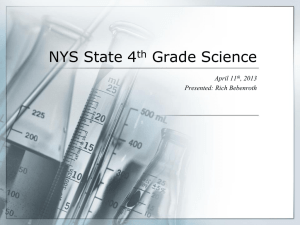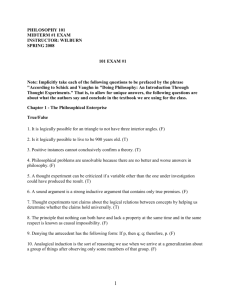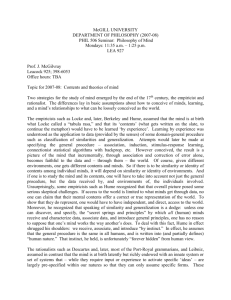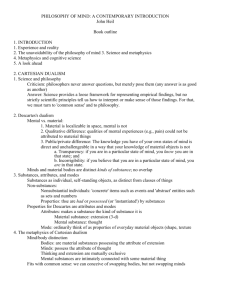Review Materials for Chapter 2 – The Mind
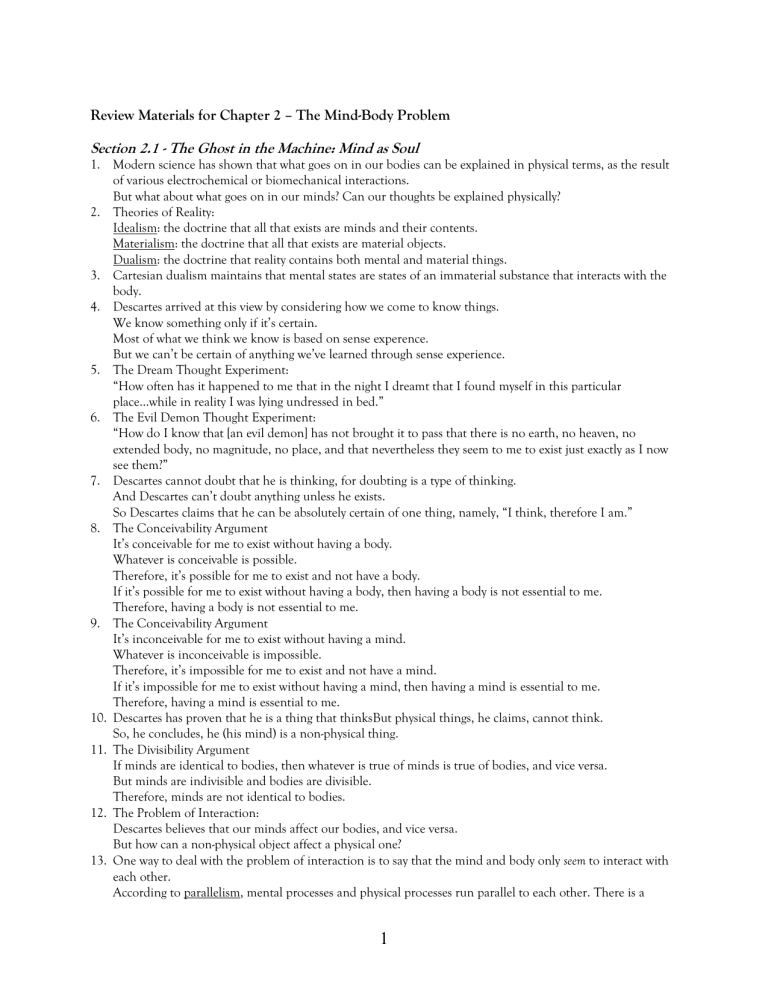
Review Materials for Chapter 2 – The Mind-Body Problem
Section 2.1 - The Ghost in the Machine: Mind as Soul
1.
Modern science has shown that what goes on in our bodies can be explained in physical terms, as the result of various electrochemical or biomechanical interactions.
But what about what goes on in our minds? Can our thoughts be explained physically?
2.
Theories of Reality:
Idealism: the doctrine that all that exists are minds and their contents.
Materialism: the doctrine that all that exists are material objects.
Dualism: the doctrine that reality contains both mental and material things.
3.
Cartesian dualism maintains that mental states are states of an immaterial substance that interacts with the body.
4.
Descartes arrived at this view by considering how we come to know things.
We know something only if it’s certain.
Most of what we think we know is based on sense experence.
But we can’t be certain of anything we’ve learned through sense experience.
5.
The Dream Thought Experiment:
“How often has it happened to me that in the night I dreamt that I found myself in this particular place…while in reality I was lying undressed in bed.”
6.
The Evil Demon Thought Experiment:
“How do I know that [an evil demon] has not brought it to pass that there is no earth, no heaven, no extended body, no magnitude, no place, and that nevertheless they seem to me to exist just exactly as I now see them?”
7.
Descartes cannot doubt that he is thinking, for doubting is a type of thinking.
And Descartes can’t doubt anything unless he exists.
So Descartes claims that he can be absolutely certain of one thing, namely, “I think, therefore I am.”
8.
The Conceivability Argument
It’s conceivable for me to exist without having a body.
Whatever is conceivable is possible.
Therefore, it’s possible for me to exist and not have a body.
If it’s possible for me to exist without having a body, then having a body is not essential to me.
Therefore, having a body is not essential to me.
9.
The Conceivability Argument
It’s inconceivable for me to exist without having a mind.
Whatever is inconceivable is impossible.
Therefore, it’s impossible for me to exist and not have a mind.
If it’s impossible for me to exist without having a mind, then having a mind is essential to me.
Therefore, having a mind is essential to me.
10.
Descartes has proven that he is a thing that thinksBut physical things, he claims, cannot think.
So, he concludes, he (his mind) is a non-physical thing.
11.
The Divisibility Argument
If minds are identical to bodies, then whatever is true of minds is true of bodies, and vice versa.
But minds are indivisible and bodies are divisible.
Therefore, minds are not identical to bodies.
12.
The Problem of Interaction:
Descartes believes that our minds affect our bodies, and vice versa.
But how can a non-physical object affect a physical one?
13.
One way to deal with the problem of interaction is to say that the mind and body only seem to interact with each other.
According to parallelism, mental processes and physical processes run parallel to each other. There is a
1
correlation between mental and physical events, but no causal interaction.
Occasionalism is the parallelist theory of the mind that claims the correlation between mental and physical events is produced on each occasion by God.
Preestablished harmony is the parallelist theory of mind that claims that the correlation between mental and physical events was established by God at the beginning of the universe.
14.
Descartes’ dualistic interactionism runs afoul of a basic principle of materialism known as the “causal closure of the physical.”
According to this principle, everything can be explained in purely physical terms.
Nevertheless, people do have thoughts, feelings, and desires, and these things seem to be nonphysical.
How can we reconcile these facts?
15.
Maybe we can reconcile them by admitting the existence of Cartesian minds and denying them any causal power.
According to epiphenomenalism, the mind is an ineffective by-product of physical processes; the body affects the mind, but the mind does not affect the body.
16.
The Problem of Other Minds:
Because Cartesian minds have no physical properties, they cannot be sensed or detected by any physical instruments.
If so, Descartes cannot know that other people have minds.
Section 2.2 - You are What You Eat: Mind as Body
1.
In order for there to be a science of the mind, empiricists held that the mind had to be observable.
2.
According to empiricism, an idea is real only if it can be derived from sense experience.
3.
According to logical empiricism, a sentence is meaningful only if it can be verified by sense experience.
4.
Since the way we verify sentences about other people’s mental states is by observing their behavior, it follows that what we mean when we say that someone is in a mental state is that they have a certain behavioral disposition. Thus, logical behaviorism has it that mental states are behavioral dispositions.
5.
Putnam’s super Spartans suggest that mental states are not behavioral dispositions because it is possible to be in a mental state and not have any particular behavioral disposition.
6.
Putnam’s argument:
If having certain behavioral dispositions were a necessary condition for being in a certain mental state, then it would be impossible to be in that state and not have those dispositions.
But, as the example of the super-Spartans shows, it is possible to be in pain and not have the behavioral dispositions associated with pain.
Therefore, having certain behavioral dispositions is not a necessary condition for being in a certain mental state.
7.
Neurophysiological research suggests that mental states are identical to brain states.
8.
If mental states are identical to brain states, they would be knowable from a third-person point of view. But as Nagle’s bat thought experiment suggests, consciousness—what it’s like to be a certain sort of thing—is not knowable from a third person point of view.
9.
Nagle’s argument:
If mental states are identical to brain states, then it is possible to know everything about the mind by knowing everything there is to know about the brain.
But, as the example of the bat shows, it’s not possible to know everything about the mind by knowing everything about the brain.
Therefore, mental states are not brain states.
10.
Lewis’s pained Martian and Putnam’s computer suggest that having a brain is not a necessary condition for having a mind because they can be realized in many different things. They are multiply realizable.
11.
Lewis’s and Putnam’s argument:
If the identity theory were true, then it would be impossible for anything without a brain to have a mind.
But, as Lewis’s pained Martian and Putnam’s conscious computer show, things without brains can have
2
minds.
So the identity theory is not true; having a brain is not a necessary condition for having a mind.
Section 2.3 - I, Robot: Mind as Software
12.
According to functionalism, mental states are functional states.
To perform a function is to take a certain input and produce a certain output.
When two things perform the same function, they are said to have the same “causal role.”
13.
The goal of artificial intelligence research is to create a machine that can think for itself; that has a mind of its own.
According to “strong AI,” there’s nothing more to having a mind than running the right kind of program.
Strong AI claims that the mind is to the brain as the software of a computer is to its hardware.
14.
As a counterexample to functionalism, Lewis considers a madman who feels pain like we do but acts much differently.
15.
Lewis’s Pained Madman argument:
If functionalism were true, it would be impossible for someone to be in pain and function differently than we do when we are in pain.
But, as Lewis’s pained madman shows, it’s not impossible for someone to be in pain and function differently than we do.
So, functionalism is false; being in a certain functional state is not a necessary condition for being in a mental state.
16.
As a counterexample to functionalism, Block considers having all the people in China runa mind program.
17.
Block’s Chinese Nation argument:
If functionalism were true, then anything that had the right sort of functional organization would have a mind.
But as Block’s Chinese nation shows, it is not the case that anything that had the right sort of functional organization would have a mind.
So functionalism is false; having the right sort of functional organization is not a sufficient condition for having a mind.
18.
As a counterexample to functionalism, Putnam considers the possibility of an inverted spectrum.
19.
Putnam’s inverted spectrum argument:
If functionalism were true, it would be impossible for people with the same functional organization to have different mental states.
But, as Putnam’s inverted spectrum shows, it’s not impossible for people with the same functional organization to have different mental states.
So functionalism is false; having a certain functional organization is not a sufficient condition for being in a certain mental state.
20.
Searle’s Chinese Room thought experiment:
Suppose that a person in a room with a rulebook and a set of Chinese symbols were able to use them to answer questions put to him in Chinese.
Nevertheless, that person wouldn’t understand Chinese.
This possibility suggests that performing a particular function is not sufficient for being in a mental state.
21.
Searle’s Chinese Room argument:
If a computer could understand a language solely in virtue of running a program, then the man in the room would understand Chinese (because he’s doing the same thing that a computer does, namely, manipulating symbols in accordance with a set of rules.)
But the man in the room doesn’t understand Chinese.
So computers can’t understand a language solely in virtue of running a program.
22.
Intentionality is the property of being of or about something.
Mental states have intentionality because they can be of or about something. The belief that the Yankees will win the pennant, for example, is about the Yankees, the pennant, and the proposition that the Yankees will win the pennant.
3
Section 2.4 - There Ain't No Such Things as Ghosts: Mind as Myth
1.
According to eliminative materialism, there are no mental states.
So reference to mental states should be eliminated from our theories of behavior.
Eliminativists believe that mental states are to brains as demons are to disease; they are an illusion.
2.
Rorty’s Demons thought experiement:
Certain tribes believe that diseases are caused by demons.
We don’t share that belief because we can explain diseases without appeal to demons.
Similarly, Rorty claims, once we can explain behavior without appeal to mental states there will be no reason to believe they exist.
3.
Folk psychology is our common-sense theory of the mind that explains people’s behavior in terms of mental states like belief and desire.
Eliminative materialists believe that psychologists will be able to explain people’s behavior without referring to mental states.
4.
Searle’s Chevrolet station wagon thought experiment:
Physicists can explain much of reality without using folk concepts such as “golf club,” “tennis racket,” or
“Chevrolet station wagon.”
But that doesn’t mean that golf clubs, tennis rackets, and Chevrolet station wagons don’t exist.
5.
If either reductive or eliminative materialism were true, it would be possible to provide a complete description of the world in purely physical terms, for there would be no nonphysical things or properties.
6.
But would a complete knowledge of all the physical facts about the world really give us a complete knowledge of the world?
7.
Jackson’s Color-challenged scientist thought experiment:
Suppose Mary knows all the physical information about the visual process, but has never seen a colored object.
Now suppose that she sees a colored object for the first time.
Will she learn anything new? If so, it seems that physical properties are not the only properties in the world.
Section 2.5 - The Whole is Greater than the Sum of its Parts: Mind as Quality
1.
One explanation of the fact that mental states can’t be reduced to physical of functional states or eliminated from our vocabulary is property dualism; that is, the view that mental states have non-physical as well as physical properties.
2.
Qualitative content and intentionality are primitive properties; they can't be reduced to anything more basic, as Jacquette's intenionality test demonstrates.
3.
Jacquettes intentionality test:
“Try using the term ‘A’ to refer, first, to the book you are holding, then to the weight of the book in your hands, then to the space it occupies, then to its color.”
You can do this without doing anything else or having different qualia.
So intentionality seems to be a primitive property.
4.
Some property dualists maintains that mental properties “supervene” on physical ones.
This means that nothing can have a mental property unless it has certain nonmental ones, and those nonmental properties give rise to the mental ones.
5.
The supervenience theory may be inconsistent. It is committed to three principles that seemingly cannot all be true:
The Irreducibility of the Mental
The Causal Efficacy of the Mental
The Causal Closure of the Physical
Which principle is it most plausible to reject?
6.
To give up the irreducibility of the mental is to embrace a reductive theory of the mind like the identity theory or behaviorism.
To give up the causal efficacy of the mental is to embrace epiphenomenalism
To give up the causal closure of the physical is to embrace some sort of downward causation.
4
7.
Non-physical mental properties may be emergent properties; they may come into being when things that lack the property interact in certain ways.
8.
An emergent property is one that comes into being (emerges) when things which lack that property interact in certain ways.
For example, life is an emergent property that comes into being when certain things that are not alive, like organic molecules, interact in certain ways.
9.
Downward causation occurs when high-level or emergent properties affect low-level basic properties.
Some neurophysiologists believe that mental properties can have a downward causal affect on physical properties.
5
